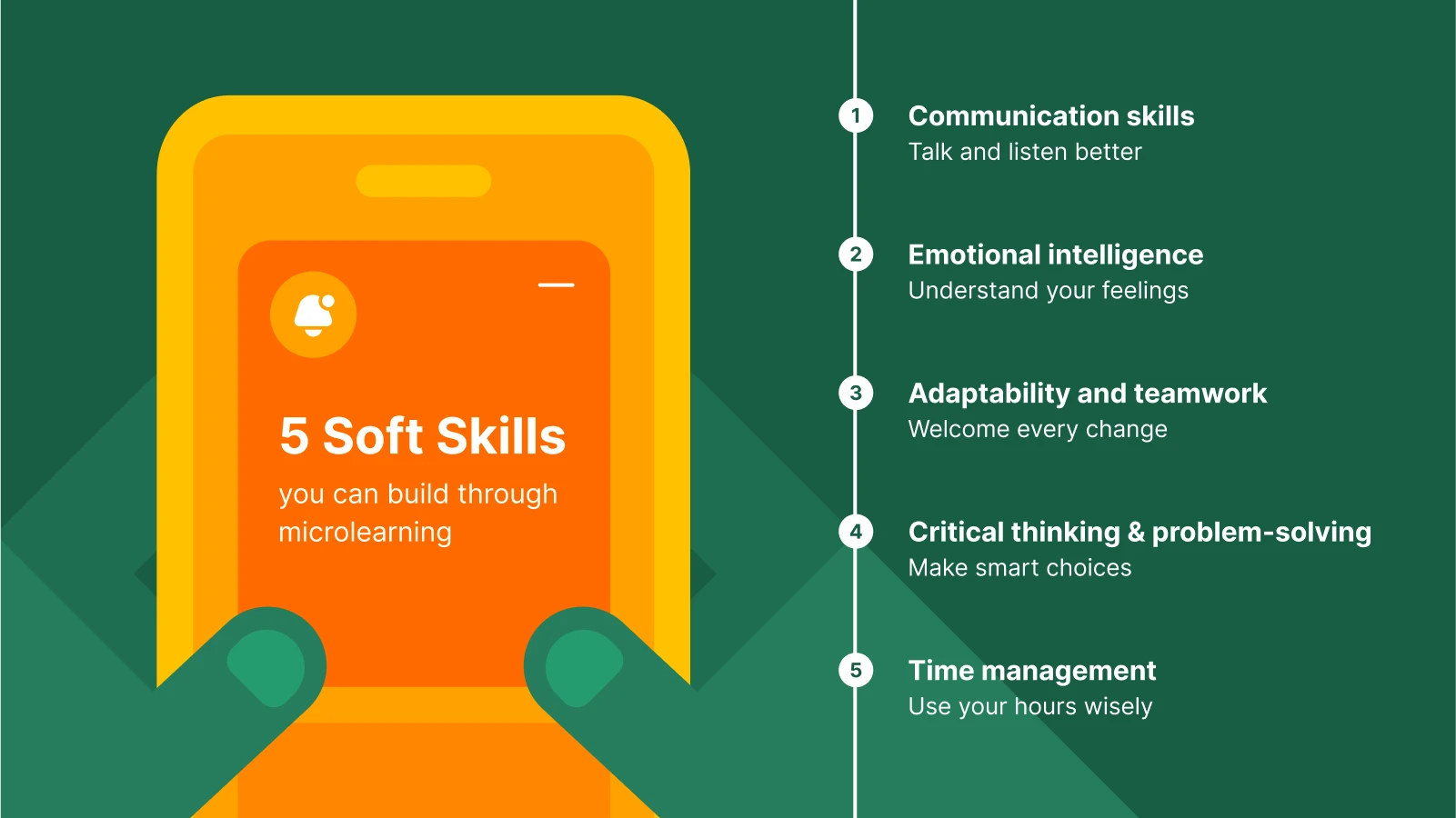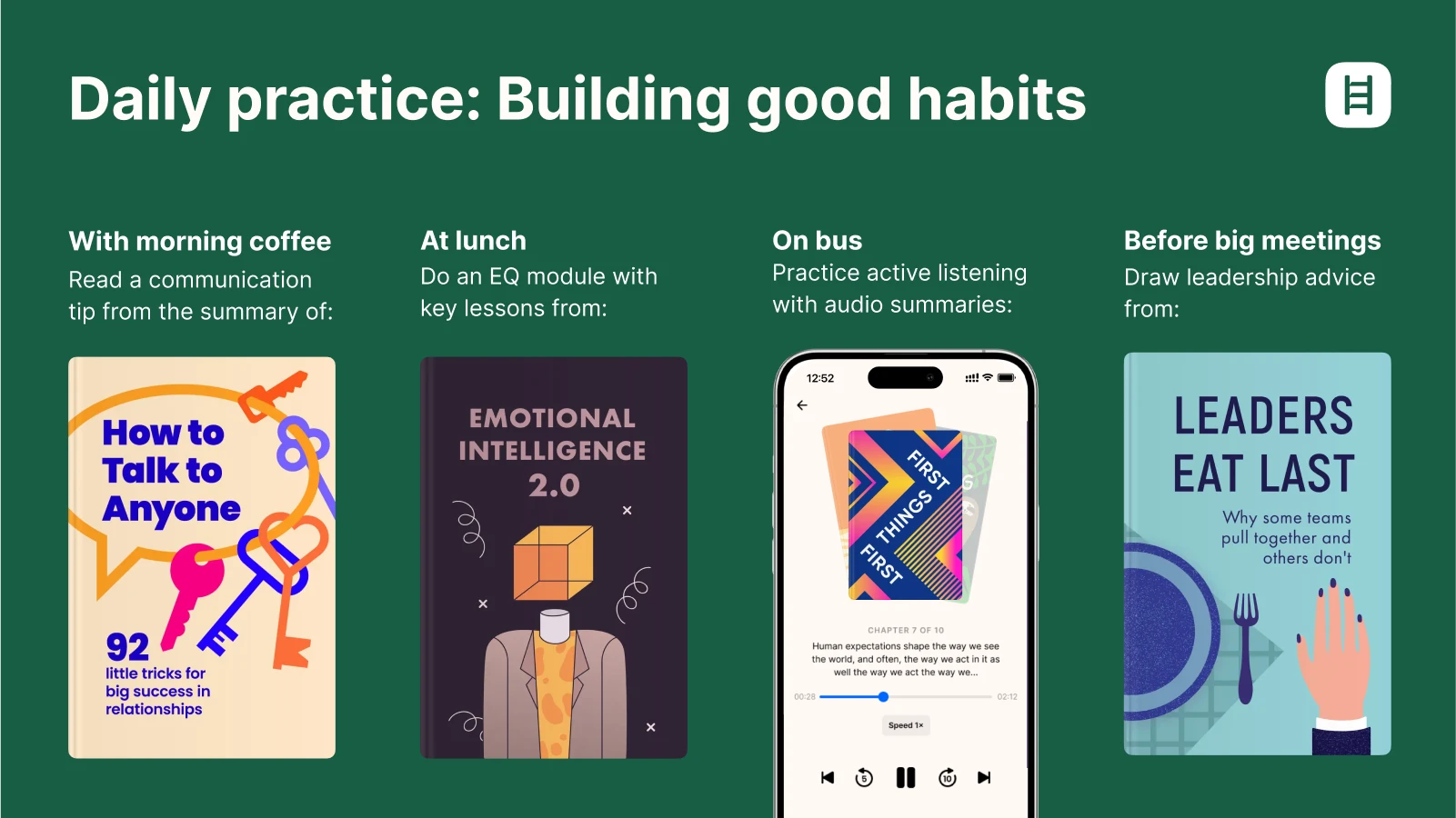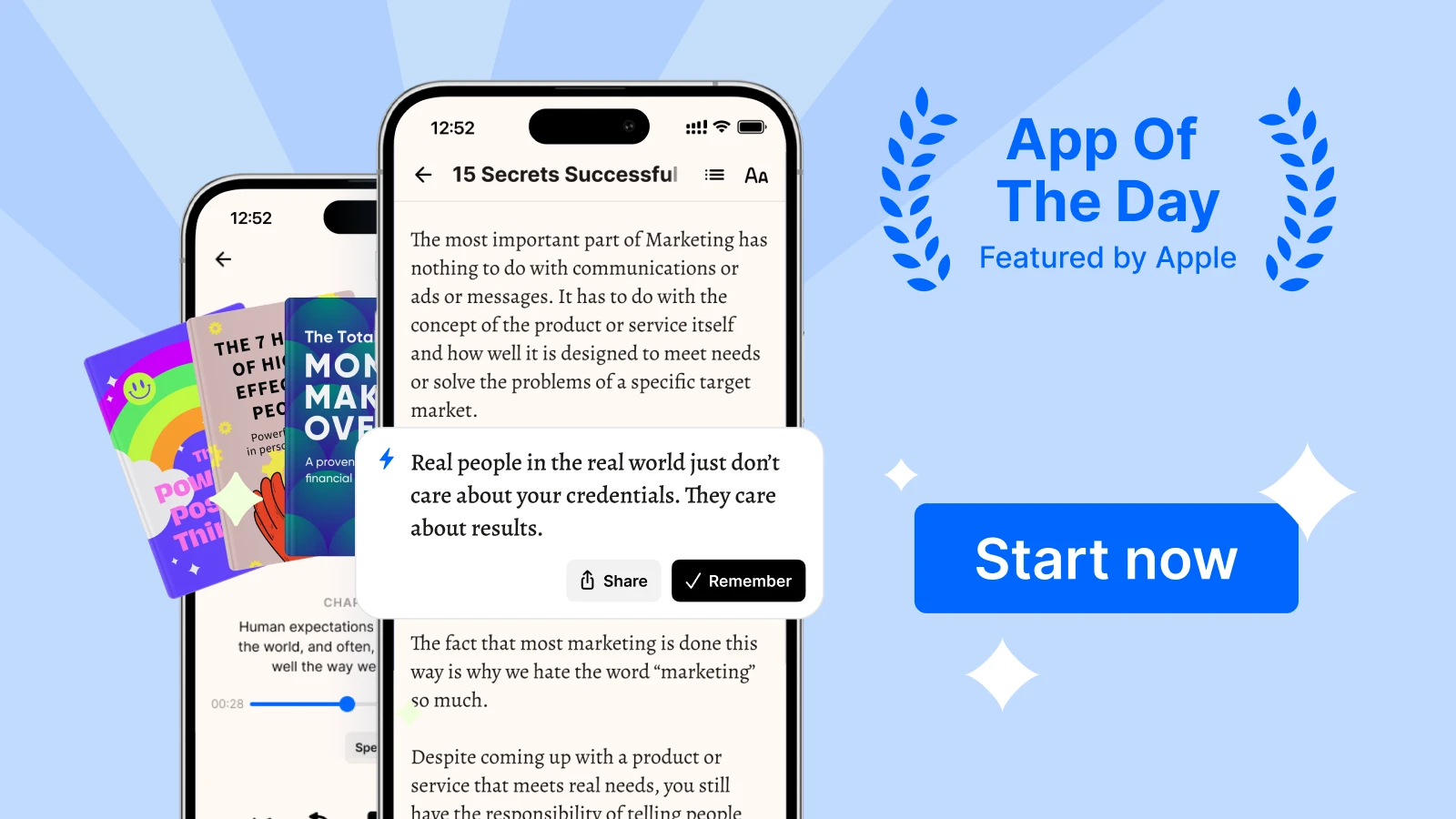Do you struggle with tough talks at work? Feel stressed when your attention span runs out? We totally hear you. The answer isn't sitting through long, boring training programs. It's through soft skills microlearning — a new way to build essential soft skills by using bite-sized learning.
Instead of spending hours in traditional training sessions, microlearning platforms like Headway give quick lessons that take just 5 to 15 minutes. You can learn during your coffee break or while waiting for the bus. It's an e-learning format that fits into your daily workflow without messing up your schedule. Get the Headway app now and enjoy your personal guide to soft skills training!
In this article, you'll learn:
How microlearning boosts your soft skills in 5-15 minute sessions.
Which soft skill can supercharge your personal growth?
Key techniques for growing skills like emotional intelligence and communication.
Practical strategies for using microlearning in your daily routine.
How Headway can help accelerate your personal growth with book summaries.
Short quiz: Which soft skill will boost your personal growth?
Take this six-question quiz and find out which soft skill drives your personal growth!
How microlearning works for soft skills development: Tools and strategies
Understanding the benefits of microlearning helps you use it better. While traditional training methods might take all day, microlearning gives you focused content in 3 to 15 minutes.
This approach matches how your brain works. Science shows we learn better when information comes in small chunks with breaks between. That's why microlearning works so well for soft skills development. So you can also use microlearning tools like these to boost your soft skills.
Interactive quizzes and activities: Learn by doing
Interactive stuff turns boring reading into active learning. Instead of just reading about teamwork, you could take a quick quiz about your style, then get feedback and action steps.
A good LMS (learning management system) tracks your progress through these activities. It finds your skills gap and adjusts to your learning needs, ensuring that each learning experience fits your goals.
Good activities include:
Questions based on real-world situations.
Tools to check your strengths.
Ways to compare with others.
Quick feedback that helps you learn.
Videos: See your skills in action
Short videos are great for showing interpersonal skills because you can see real people interact. A 3-minute video about running meetings teaches more than hours of reading. You can even watch these videos on any device, making online learning easy wherever you are.
High-quality video content includes:
Real workplace scenes.
Expert talks.
Cartoons explaining hard ideas.
Before and after examples.
Games: Make every learning round fun
Gamification uses points, badges, and leaderboards to make learning feel like a game. This method works great for soft skills because it makes you care about learning.
When you earn a badge for finishing communication modules, you feel good about learning. Many learners say gamified microlearning feels more like fun than work.
Book summaries: Start small, think big
Headway book summaries are powerful tools for building soft skills without the time commitment of reading full books. Each summary takes up to 15 minutes to read or listen to, but gives you the key ideas from bestselling books about communication, teamwork, leadership, and emotional intelligence.
Think of Headway as your personal soft skills coach. Need to improve your teamwork? There's a book summary for that. Want better problem-solving skills? Our learning app has summaries for that too! These bite-sized lessons turn big ideas from famous authors into practical tools you can use at work today.
The top five soft skills you can build through microlearning
Let's look at the soft skills that quickly improve when you use bite-sized learning methods.
1. Communication skills: Talk and listen better
Good communication skills involve more than just talking. You need to know how to listen, read body language, and change how you talk based on who you're talking to.
Microlearning makes soft skills training practical. Instead of sitting through long training sessions, you get bite-sized practice that mimics real-life situations.
Here's how it works: You spend 5 minutes in an online learning simulation where you handle conflict resolution with a coworker.
This microlearning approach lets you practice decision-making skills safely and see the results. You learn from mistakes before using these new skills in your actual work environment.
Communication modules often include:
Daily tips for active listening.
Short videos about body language.
Quick quizzes about tone and delivery.
Case studies from real workplaces.
2. Emotional intelligence: Understand your feelings
Emotional intelligence means understanding your own feelings and the feelings of others. It's one of the most important parts of professional development today.
Instead of sitting through hours of lectures, microlearning courses break this complex topic into small pieces. You could spend 3 minutes learning about yourself one day, then practice understanding others the next. This just-in-time learning helps you build emotional intelligence bit by bit.
Studies show that learners who use microlearning for emotional intelligence remember 23% more than those in traditional training. What's the secret? Well, those small, regular doses of learning can help your brain process information better. This method improves the retention of what you learn.
3. Adaptability and teamwork: Welcome every change
Things change all the time at work: new technology, new team members, new ways of doing things. Your adaptability decides if you'll succeed. Microlearning is great for building this skill because it works the same way change does, through small steps and not huge jumps.
Through short learning sessions, you can develop:
Ways to handle stress.
Methods for dealing with change.
Tools to stay productive when things shift.
Skills to help your teamwork improve during changes.
Want to know the best part about the microlearning platform approach? You can find what you need, exactly when you need it. Got a big change at work? Pull up a 4-minute module during lunch.
4. Critical thinking and problem-solving: Make smart choices
Problem-solving skills matter in every job. But learning these competencies used to mean attending long workshops. Microlearning changes this by giving you mini-challenges that make you think without taking up your whole day.
Modern e-learning uses gamification to make problem-solving fun. You could solve puzzles, work through tough choices, or look at real business problems — all within 5 to 10 minutes. This strategy helps you build critical thinking skills step by step.
Problem-solving modules include:
Daily brain games for your industry.
Quick decision-making practice.
Simple infographics about thinking mistakes.
Short videos showing problem-solving steps.
5. Time management: Use your hours wisely
Time management isn't just about calendars. It's about knowing when you work best, setting limits, and choosing what's most important. Microlearning works great for this because it shows you how to learn and get results in short periods — just like it teaches!
Through microlearning, you can learn:
How to pick what's most important.
Ways to avoid distractions.
When to say no.
How to balance work and life.
Soft skills training: How can you use microlearning in your routine?
The secret to successful microlearning isn't about finding more time. It's more about using the time you already have more wisely. Follow along, and you'll see how to make learning as natural as checking your phone!
Daily practice: Building good habits
The key to upskilling through microlearning is practicing regularly, not doing a lot at once. Instead of trying to learn everything in one day, commit to short, regular learning. This approach fits naturally into busy schedules and works with how your brain actually learns best.
Try adding microlearning to things you already do:
Read a communication tip from the summary of 'How to Talk to Anyone' with morning coffee.
Do an emotional intelligence module with key lessons from 'Emotional Intelligence 2.0' at lunch.
Practice active listening with audio summaries on the bus.
Draw leadership advice from 'Leaders Eat Last' before big meetings..
The goal is to make learning feel natural, not like extra work.
Make it happen with Headway: Transform your daily routines into learning opportunities with Headway's bite-sized text and audio summaries from bestselling nonfiction. And yo'll see that personal growth doesn't require extra time, just smart integration with activities you're already doing.
Using apps like Headway and LinkedIn Learning
Headway shows how microlearning works. Instead of reading whole books about self-improvement, it gives you the main ideas in 15 minutes or less.
Short on time? No need to flip through the entire 300-page 'The 7 Habits of Highly Effective People.' Read its short summary on the Headway app and grasp Stephen Covey's core principles in 15 minutes!
LinkedIn Learning also uses microlearning ideas. They offer short courses that professionals can finish during work breaks.
These platforms understand that learners need flexibility. Whether you have 5 minutes or 20, you can make progress on your learning objective at your own pace.
Why Headway leads the way: While other platforms offer courses, Headway specializes in delivering fast, powerful learning through bite-sized lessons. You get the most valuable insights without the fluff, making it perfect for busy professionals who want maximum impact in minimum time.
Tracking your progress
Good microlearning is about choosing the right things to learn at the right time. Work on just one or two skills instead of trying to learn everything at once. It's better to learn a little bit well than a lot poorly.
Follow these simple tips:
Learn for less than 20 minutes each day — start with one book summary.
Practice what you learn, don't just read about it.
Give yourself breaks to think about what you learned — a reading journal is a great start.
Choose personalized lessons on the Headeway app that solve problems you have right now.
Use Headway for progress check: Headway ensures you're always learning something relevant to your current challenges. Personal growth is always one tap away, making it easier than ever to maintain consistency and see real results in your professional and personal life.
Three microlearning challenges and how to overcome them
While microlearning has many benefits, you might face some problems.
1. Stay interested: Even though microlearning is easier than traditional learning, you still need to stay motivated. Think of it as investing in yourself, not just another task.
Ways to stay interested:
Set goals that connect to your job.
Learn with friends or coworkers.
Celebrate when you finish modules.
Mix up what you learn.
Connect learning to work problems.
Remember, building technical skills and soft skills takes time. Small, regular sessions add up to big changes.
2. Not overdoing it: With so many modules and videos available, you might be tempted to learn too much too fast. Try to avoid this, as this approach hurts retention and makes it hard to use what you learn.
Good microlearning means being smart about what and when you learn. Focus on one or two skills at a time. Quality matters more than quantity.
Follow these rules:
Keep daily learning under 20 minutes.
Focus on using skills, not just knowing them.
Take time to think between sessions.
Pick content that helps with current problems.
3. Use what you learn: The real test is whether you use new skills in real situations. Microlearning helps by using simulations and scenarios modeled after the workplace.
To use what you learn:
Pick goals that match current challenges.
Practice in easy situations first.
Ask for feedback from others.
Write down when you use new skills well.
Share what you learn with your team.
Pump up your soft skills with Headway microlearning
Soft skills microlearning isn't just another training method but a chance to build your learning and development strategy. With Headway, you don't need to change your whole life. Just spend a few minutes each day reading or listening to book summaries that build your soft and hard skills.
Let the key insights from bestsellers like 'Atomic Habits' and 'The ONE Thing' guide you to success and real-time changes.
Download the Headway app and start your microlearning journey today. See how small daily readings create big changes in your teamwork, problem-solving abilities, and overall effectiveness in the modern workplace.
Frequently asked questions about soft skills microlearning
What is microlearning for soft skills?
Microlearning for soft skills means taking quick, small lessons that last only 5 to 15 minutes. They teach you how to talk with others and understand feelings at work. Instead of sitting through long classes, you can learn in small chunks that fit your schedule. This method helps you remember more and practice skills right away at work or home.
What are the five most important soft skills?
The five most important soft skills are communication, teamwork, problem-solving, adaptability, and time management. Communication helps you talk and listen better. Teamwork is getting along with other people. Problem-solving is figuring out how to fix things that go wrong. Adaptability means being okay when things change. Time management is finishing everything on time.
How to start learning soft skills?
Start by identifying the skills you need to improve, then use resources like microlearning modules or book summaries for regular practice and feedback. Apps like Headway offer quick daily lessons. Set aside just 10 minutes each day to practice what you learn at work. Ask friends or coworkers how you're doing.
What is the meaning of microskills?
Microskills are small, specific abilities like listening or time management that contribute to broader skill sets. Think of them as building blocks. For example, nodding while someone talks is a microskill that helps with bigger communication skills. These tiny actions add up to make you better at your job.
What is soft skill training?
Soft skill training focuses on developing abilities like communication and emotional intelligence to improve how people interact and work together. Unlike learning computer programs or machines, soft skill training teaches you about working with people. It includes lessons on listening, leading teams, solving conflicts, and understanding feelings at work.
How to learn soft skills fast?
The fastest way to build soft skills is to learn a little bit every day. Use apps like Headway to read short book summaries in just 15 minutes. Try out what you learn at work the same day, or watch quick teaching videos when you have free time.















